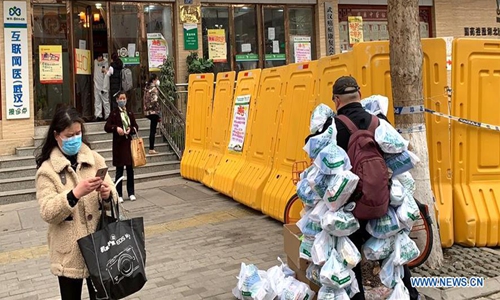HOME >> CHINA
Hubei extends strictest virus control
By Deng Xiaoci and Zhang Han Source:Global Times Published: 2020/3/1 21:23:40 Last Updated: 2020/3/1 22:28:40
Positive signs emerge nationwide, but experts warn of rebound

A community service worker carries medicines for residents in Jiang'an District of Wuhan, capital of central China's Hubei Province, Feb. 24, 2020. Feng helped residents in Huiminyuan community to buy medicines for chronic diseases on Monday. He found a fresh way to hang the medicines on his body as there were too much bags to carry. (Xinhua)
The strictest measures will be continued on the containment of the COVID-19 epidemic in Central China's Hubei Province, the epicenter of the outbreak, to ensure the hard-won gains persist, according to the city regulators, a move that observers and frontline medics said is needed to prevent the province and the nation from encountering a rebound of the disease.
The Ministry of Transport issued a document on Sunday to suspend all online car-hailing and ride-sharing service leaving Hubei.
According to National Health Commission data, three COVID-19 confirmed cases were reported on Saturday outside Hubei, marking a third consecutive day of single-digit growth in the category.Saturday also witnessed the first time that recovered COVID-19 patients outnumbered the remaining confirmed infections.
Meanwhile, 570 COVID-19 confirmed cases were reported on Saturday, including 565 from Wuhan, capital of Hubei Province. Five other Hubei cities reported one confirmed case each, with zero reports in the remaining 10 city areas.
Such data showed that Wuhan remains home to the great majority of new COVID-19 infections, and no one should let down their guard just yet or follow prevention and control measures that are any less than the strictest, observers noted.
Despite the decreasing number of new cases and the rise in recovered patients, Peng Zhiyong, director of the intensive care unit of the Zhongnan Hospital of Wuhan University, embraced continuation of the "strictest-ever" measures in epicenter of the outbreak.
The positive signs resulted from previous quarantine and other control measures. Infections may rebound if control measures ease, Peng said, noting it is critical to be cautious yet positive about the overall situation.
Although there are fewer new infections, rescue of current patients and preventing mild cases from worsening remain major tasks, Peng said.
Despite the rigorous lockdown of communities, there are still 400 new COVID-19 cases reported daily in Wuhan, Yang Zhanqiu, a Wuhan virologist said, noting it could show the shift of people from the incubation stage, rather than resulting from human-to-human transmission.
Luo Yamen, a Beijing-based urban management expert, agreed on the extension of tough handling in Hubei, especially in Wuhan and the city's neighboring regions, as there are still unknown areas about the epidemic, as well as an unknown number of people susceptible of infection.
"If we relax control measures at this time, there would be great chances of encountering epidemic rebounds," he warned.
Li Yang, a deputy director with the Hubei provincial disease prevention and control center, vowed at a Saturday press conference that the province will push forward full coverage all individuals, all residential communities, and all public areas in the epidemic control work.
Also, work at the rescue and treatment stage as well as that related to the cut-off of transmission routes, was stressed by the official.
The province released its first assessment report of the epidemic risk of 103 county-level regions in three groups on Saturday, and 11 counties in the west part of the province were categorized in the low-risk group, meaning there had been no discovery of new COVID-19 cases for two weeks.
Thirty-four counties in the province with less than 50 confirmed cases in the past 14 days were grouped in the middle-risk category and 58 with more than 50 new cases were labeled as high-risk.
Local authorities were ordered to take region-specific approaches when advancing resumption of work and production based on local health risks, according to decisions at a central authorities' meeting, the Xinhua News Agency reported on Thursday.
Regions with relatively low risks should focus on preventing imported cases and comprehensively restoring the order of production and life. Medium-risk regions should promote work and production resumption in an orderly manner based on local situations, while high-risk regions should continue to be fully committed to epidemic prevention and control, it said.
By the end of April, or at the beginning of May, hopefully, people outside Hubei could take off their masks and resume their normal lives. The time for Wuhan should be later and that needs more time to assess, observers predicted.
Posted in: SOCIETY,CHINA FOCUS